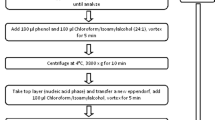Abstract
Free amino acids (FAA) and protein have been measured in whole laboratory-readed halibut larvae and on dissected individuals separated into yolk and body compartments. At hatching both FAA and protein are mainly located in the yolk compartment. During the first 12 d of the yolk-sac stage more than 70% of the FAA pool disappeared from the yolk without any significant changes in the yolk protein pool. This suggests different uptake mechanisms for FAA and protein from the yolk, and a sequential utilisation of the endogeneous reservoirs of free and protein amino acids in Atlantic halibut larvae. The data suggest that in the early yolk-sac stage FAA enter the embryo from the yolk and are utilised both for energy and protein synthesis. Later on when the free pool cannot fulfil the nutritional requirements, additional amino acids are recruited from yolk protein. Of the total amino acids (free + protein amino acids) present at hatching ca. 60% will be used as precursors for body protein synthesis while the remaining 40% are used as fuel in the larval energy metabolism.
Similar content being viewed by others
Literature cited
Ash, R. (1985). Protein digestion and absorption. In: Cowey, C. B., Mackie, A., Bell, J. B. (eds.) Nutrition and feeding in fish. Academic Press, London, p. 69–91
Blaxter, J. H. S., Hempel, G. (1966). Utilization of yolk by herring larvae. J. mar. biol. Ass. U.K. 46: 219–234
Finn, R. N. (1989). The energy and nitrogen metabolism of Atlantic halibut eggs Hippoglossus hippoglossus. MSc thesis. University of Stirling, Stirling
Fyhn, H. J. (1989). First feeding of marine fish larvae: are free amino acids the source of energy? Aquaculture, Amsterdam, 80: 111–120
Fyhn, H. J. (1990). Energy production in marine fish larvae with emphasis on free amino acids as a potential fuel. In: Mellinger, J. (ed.) Nutrition in wild and domestic animals. 5. Karger, Basel, p. 176–192
Hamor, T., Garside, E. T. (1973). Peroxisome-like vesicles and oxidative activity in the zona radiata and yolk of the ovum of the Atlantic salmon (Salmo salar L.). Comp. Biochem. Physiol. 45B: 147–151
Heming, T. A., Buddington, R. K. (1988). Yolk absorption in embryonic and larval, fishes. In: Hoar, W. S., Randall, D. J. (eds.) Fish physiology. XI A. Academic Press, San Diego, p. 407–446
Lasker, R. (1962). Efficiency and rate of yolk utilization by developing embryos and larvae of the Pacific sardine Sardinops caerulea (Girad). J. Fish. Res. Bd Can. 195: 867–875
Lowry, O. H., Rosebrough, N. J., Farr, A. L., Randall, R. R. (1951). Protein measurement with the Folin phenol reagent. J. biol. Chem. 193: 265–275
Mangor-Jensen, A. (1987). Water balance in developing eggs of cod (Gadus morhua L.). Fish Physiol. Biochem. 3: 17–24
Murakami, M., Iuchi, I., Yamagami, K. (1990). Yolk phosphoprotein metabolism during early development of the fish Oryzias latipes. Dev. Growth Differentiation 326: 619–627
Nakagawa, H., Tsuchiya, Y. (1972). Studies on rainbow trout egg (Salmo gairdnerii irideus) IV. Changes of yolk content during embryogenesis. J. Fac. Fish. Anim. Husb. Hiroshima Univ. 112: 111–118
Potts, W. T. W., Rudy, P. P. (1969). Water balance in eggs of the Atlantic salmon Salmo salar. J. exp. Biol. 50: 223–237
Riis-Vestergaard, J. (1987). Physiology of teleost embryos related to environmental challenges. Sarsia 72: 351–358
Rudy, P. P., Potts, W. T. W. (1969). Sodium balance in eggs of the Atlantic salmon Salmo salar. J. exp. Biol. 50: 239–246
Rutter, W. J. (1967). Protein determination in embryos. In: Wilt, F. H., Wessels, N. K. (eds.) Methods in developmental biology. Academic Press, New York, p. 671–684
Rønnestad, I., Fyhn, H. J., Gravningen, K. (1992a). The importance of free amino acids to the energy metabolism of eggs and larvae of turbot (Scophthalmus maximus). Mar. Biol. 114: 517–525
Rønnestad, I., Finn, R. N., Groot, E. P., Fyhn, H. J. (1992b). Utilization of free amino acids related to energy metabolism of developing eggs and larvae of lemon sole Microstomus kitt reared in the laboratory. Mar. Ecol. Progr. Ser. 88: 195–205
Rønnestad, I., Fyhn, H. J. (1993). Importance of free amino acids in embryonic energy production of three marine flatfishes as revealed by measurements of oxygen consumption and ammonia production. In: Walther, B. T., Fyhn, H. J. (eds.) Physiology and biochemistry of marine fish larval development. Univ. of Bergen, Bergen (in press)
Senstad, K. (1984). Morfologisk og eksperimentell undersøkelse av kveitelarver (Hippoglossus hippoglossus L.) med resultat fra et fôringsforsøk. Cand. scient. thesis, University of Bergen, Bergen (in Norwegian)
Skiftesvik, A. B., Pittman, K. A., Opstad, I., Bergh, Ø. (1991). When do halibut (Hippoglossus hippoglossus L.) larvae first feed? In: Pittman, K. A. Aspects of the early life history of the Atlantic halibut (Hippoglossus hippoglossus L.): embryonic and larval development and the effects of temperature. PhD thesis, Univ. of Bergen, Bergen, MS 5
Thorsen, A., Fyhn, H. J. (1991). Osmotic effectors during preovulatory swelling in marine fish. In: Scott, A. P., Sumpter, J. P., Kime, D. E., Rolfe, M. S. (eds.) Fish symp. 91. University of Sheffield, Sheffield, p. 312–314
Author information
Authors and Affiliations
Additional information
Communicated by T.M. Fenchel
Rights and permissions
About this article
Cite this article
Rønnestad, I., Groot, E.P. & Fyhn, H.J. Compartmental distribution of free amino acids and protein in developing yolk-sac larvae of Atlantic halibut (Hippoglossus hippoglossus). Marine Biology 116, 349–354 (1993). https://doi.org/10.1007/BF00350051
Received:
Accepted:
Issue Date:
DOI: https://doi.org/10.1007/BF00350051



